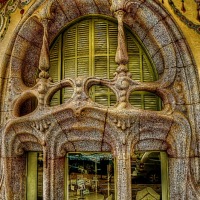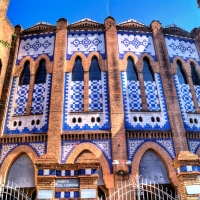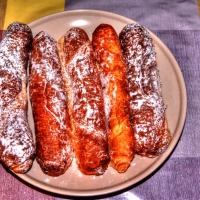Here be dragons
After Tuesday’s post, I realized/remembered that Barcelona is actually full of dragons! The modernists loved them, Gaudi made some, the most famous one being the one in Park Guell. So here is one which figures on the monumental vases on both sides of Passeig Lluis Company. There are many many more, you jusr have to know how and where to find them. We will!
The title of this post refers to the Hunt-Lenox Globe, a map made around 1503-1507, the world’s third-oldest world map. In modern day China, called East India on the map, it says HC SVNT DRACONES, or here are the Dagroians, described by Marco Polo as living in the Kingdom of “Dagroian”. These people… feasted upon the dead and picked their bones” (B.II. c.14).
Dragons appear on a few other historical maps.
- The T-O Psalter world map (ca. 1250 AD) has dragons, as symbols of sin, in a lower “frame” below the world, balancing Jesus and angels on the top, but the dragons do not appear on the map proper.
- The Borgia map (ca. 1430 AD), in the Vatican Library, states, over a dragon-like figure in Asia (in the upper left quadrant of the map), “Hic etiam homines magna cornua habentes longitudine quatuor pedum, et sunt etiam serpentes tante magnitudinis, ut unum bovem comedant integrum.” (“Here there are even men who have large four-foot horns, and there are even serpents so large that they could eat an ox whole.”) The latter may refer to the dragons of the Chinese dragon dance.
- The Fra Mauro Map (ca. 1450) has the “Island of Dragons” (Italian: Isola de dragoni), an imaginary island in the Atlantic Ocean. In an inscription near Herat, Fra Mauro says that in the mountains nearby “there are a number of dragons, in whose forehead is a stone that cures many infirmities”, and describes the locals’ way of hunting those dragons to get the stones. This is thought to be based on Albertus Magnus’s treatise De mineralibus. In an inscription elsewhere on the map, the cartographer expresses his skepticism regarding “serpents, dragons and basilisks” mentioned by “some historiographers”.
- A 19th-century Japanese map, the Jishin-no-ben, in the shape of Ouroboros depicts a dragon associated with causing earthquakes.









Beautiful!
LikeLike
May 3, 2012 at 11:49 pm
Superb image Rob, good luck on the 'dragon hunt'!!
LikeLike
April 28, 2012 at 4:27 pm
Fascinating information here! And of course your photo is great too.
LikeLike
April 28, 2012 at 7:27 am
I've always found old maps fascinating too, though my interest hasn't led to any kind of research yet, unlike yours. I always thought the dragons and sea serpents just indicated the unknown. Beautiful shot.
LikeLike
April 28, 2012 at 6:24 am
Fabulous indeed! I simply love this shot. What a great background.
LikeLike
April 27, 2012 at 4:38 pm
Rob, this is a fabulous shot for composition, focal length and color. I did not know about the connection between Barcelona and dragons.
Thanks for the tip on collages.
Bises,
Genie
LikeLike
April 26, 2012 at 3:27 pm
a beautiful image, rob.
LikeLike
April 26, 2012 at 11:09 am